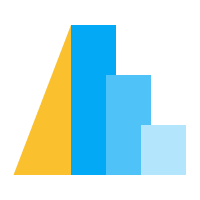Multi-Line Tooltip#
This example shows how you can use selections and layers to create a tooltip-like behavior tied to the x position of the cursor. If you are looking for more standard tooltips, see the Multi-Line Tooltip (Standard) example.
In this example, we’ll employ a little trick to isolate the x-position of the cursor: we add some transparent points with only an x encoding (no y encoding) and tie a nearest selection to these, tied to the “x” field.
import altair as alt
import pandas as pd
import numpy as np
np.random.seed(42)
columns = ["A", "B", "C"]
source = pd.DataFrame(
np.cumsum(np.random.randn(100, 3), 0).round(2),
columns=columns, index=pd.RangeIndex(100, name="x")
)
source = source.reset_index().melt("x", var_name="category", value_name="y")
# Create a selection that chooses the nearest point & selects based on x-value
nearest = alt.selection_point(nearest=True, on="pointerover",
fields=["x"], empty=False)
# The basic line
line = alt.Chart(source).mark_line(interpolate="basis").encode(
x="x:Q",
y="y:Q",
color="category:N"
)
# Transparent selectors across the chart. This is what tells us
# the x-value of the cursor
selectors = alt.Chart(source).mark_point().encode(
x="x:Q",
opacity=alt.value(0),
).add_params(
nearest
)
when_near = alt.when(nearest)
# Draw points on the line, and highlight based on selection
points = line.mark_point().encode(
opacity=when_near.then(alt.value(1)).otherwise(alt.value(0))
)
# Draw text labels near the points, and highlight based on selection
text = line.mark_text(align="left", dx=5, dy=-5).encode(
text=when_near.then("y:Q").otherwise(alt.value(" "))
)
# Draw a rule at the location of the selection
rules = alt.Chart(source).mark_rule(color="gray").encode(
x="x:Q",
).transform_filter(
nearest
)
# Put the five layers into a chart and bind the data
alt.layer(
line, selectors, points, rules, text
).properties(
width=600, height=300
)
import altair as alt
import pandas as pd
import numpy as np
np.random.seed(42)
columns = ["A", "B", "C"]
source = pd.DataFrame(
np.cumsum(np.random.randn(100, 3), 0).round(2),
columns=columns, index=pd.RangeIndex(100, name="x")
)
source = source.reset_index().melt("x", var_name="category", value_name="y")
# Create a selection that chooses the nearest point & selects based on x-value
nearest = alt.selection_point(nearest=True, on="pointerover",
fields=["x"], empty=False)
# The basic line
line = alt.Chart(source).mark_line(interpolate="basis").encode(
x="x:Q",
y="y:Q",
color="category:N"
)
# Transparent selectors across the chart. This is what tells us
# the x-value of the cursor
selectors = alt.Chart(source).mark_point().encode(
x="x:Q",
opacity=alt.value(0),
).add_params(
nearest
)
when_near = alt.when(nearest)
# Draw points on the line, and highlight based on selection
points = line.mark_point().encode(
opacity=when_near.then(alt.value(1)).otherwise(alt.value(0))
)
# Draw text labels near the points, and highlight based on selection
text = line.mark_text(align="left", dx=5, dy=-5).encode(
text=when_near.then("y:Q").otherwise(alt.value(" "))
)
# Draw a rule at the location of the selection
rules = alt.Chart(source).mark_rule(color="gray").encode(
x="x:Q",
).transform_filter(
nearest
)
# Put the five layers into a chart and bind the data
alt.layer(
line, selectors, points, rules, text
).properties(
width=600, height=300
)
